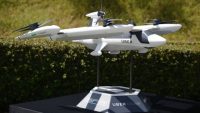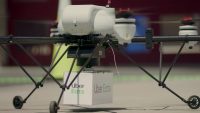Uber demonstrated the transport of a McDonald’s meal via its Uber Elevate A4200 drone with custom-designed delivery box. The drone was set to fly only half a mile away, but the trip was canceled due to a 26-knot breeze. The demo is still noteworthy as a practical application of the technology. Uber isn’t the only company pinning some of its high-tech hopes on drone delivery. Google already has the greenlight from the Federal Aviation Administration (FAA) to make similar unmanned commercial deliveries in Virginia, and Amazon also debuted its drone delivery service.
Bloomberg reports that Uber Elevate, which is still waiting for FAA approval, plans to focus on meal delivery and will launch in San Diego this summer. Delivery fees “can range up to $8.50.” Although Uber has had a difficult year, “Uber Eats has been a bright spot, reporting revenue of $1.5 billion in 2018, almost 150 percent higher than a year earlier.”

“What’s convinced me on drone delivery is to see how Uber Eats has grown,” said Uber Elevate head Eric Allison. “Our customers want selection, quality, and efficiency — all areas that improve with drone delivery.” Investment firm Cowen reported that “the food-delivery business is estimated to increase 12 percent a year, to $76 billion in 2022.”
Figures Uber released prior to its IPO show that the company spent “about $457 million on research and development in 2018.” The same year, the FAA also picked San Diego as one of 10 locations to test commercial drones. The city of San Diego partnered with Uber.
“To envision where we are in drone technology, imagine that this is two years before the introduction of cell phones,” said San Diego State University head of innovation Stanley Maloy. “The next step is a brick-size phone to carry around. And it’s a decade before we see smartphones.” The city is testing drones for blood delivery and monitoring of soil composition for farmers.
Safety and noise pollution are two reasons why Uber is not yet sending drones to homes. Instead, the plan is to send them to land “on the roof of a parked Uber car outfitted with a QR code, which will transport the food to the last leg to its destination.” Uber Elevate head of policy Kate Fraser, formerly with the FAA, “believes drone food delivery will take at least three years to be implemented in a handful of markets.”
VentureBeat reports that “Uber says its fleet of off-the-shelf drones will fly to designated landing zones, where couriers will pick up deliveries, all of which are packaged in custom-designed insulating containers” as well as possibly land on the roofs of Uber cars. Uber reported it can fulfill orders in about seven minutes, versus 21 minutes via ground transportation to a destination 1.5 miles away.

Other companies attempting to develop drone delivery services include Microsoft, Flytrex, FedEx and Matternet. Gartner “projected the number of commercial drones sold that year would exceed 174,000.” The drone market is estimated to be worth $127 billion by 2020.
For more information on the Uber Eats drone delivery demo, see the video posted on YouTube.
Related:
Uber Air Picks Melbourne as Its First International Launch City, TechCrunch, 6/11/19

No Comments Yet
You can be the first to comment!
Sorry, comments for this entry are closed at this time.